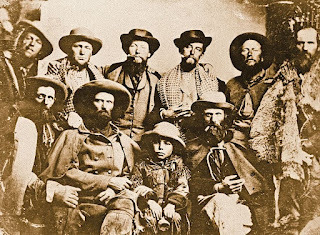An Utter Tragedy.

We will soonbe off on a trip along the Oregon Trail through southern Idaho and into westernOregon and Washington. There’s a lot of history along this nineteenth-centurysuperhighway.
Stretchedacross more than a hundred miles of the road is the history of one of thesaddest tales on the emigrant trails—a series of events known by various names,but most often as the Utter-Van Ornum Massacre. As with much of history, thereis a lot of confusion surrounding what happened. But here’s the gist of it.
ShoshoneIndians attacked an emigrant company of some 44 travelers somewhere west of thepresent location of Mountain Home, Idaho, and somewhere south of present-day Boise.Several pioneers were killed and after more fighting and needing water, four ofthe eight wagons were abandoned. The emigrants lost other people in attacksover the next few days as they traveled until the Shoshone departed. With little to eat, thetravelers left the remaining wagons and walked to the Owhyhee River, near the desertedFort Boise. Indians there traded salmon for the remainder of the emigrants’belongings and guns, then severe hunger set in.
The seniorVan Ornum, along with a few surviving members of the Utter family, left thehunger camp and moved on. The move did not save them, but it may have keptthem—at least the children—from being eaten. Four dead children were consumed inthe camp and there was talk of killing another for food. Instead, the body of aman dead ten days was exhumed, but before he was eaten help arrived and 12survivors were rescued.
Meanwhile,Indians had attacked and killed the Van Ornum party, except for three girls anda boy who were taken captive. It’s fairly certain the girls were soon killed,and perhaps the boy—but his fate remains a mystery. There were claims andstories of a white boy living with Indians at various places.
Respondingto one such story, the boy’s uncle came from Oregon and convinced army troopsfrom Camp Douglas in Utah to rescue the boy from a Shoshone band in CacheValley. After some shooting, some negotiating, and some double dealing, the boywas taken. Although he had light hair and eyes, his identity was and issuspect. He was about the right age to be the Van Ornum boy, but spoke noEnglish and was Shoshone in all his ways, and fought his “rescuers” to noavail. The Shoshone said he was the son of a French mountain man and a sisterof Chief Washakie. A photo memorializes the capture, with the boy in the bottomrow, flanked by the army officer who led the expedition and his uncle.
The uncletook him to Oregon, and to California soon after. Then history loses track ofthe boy, and his fate is unknown.



